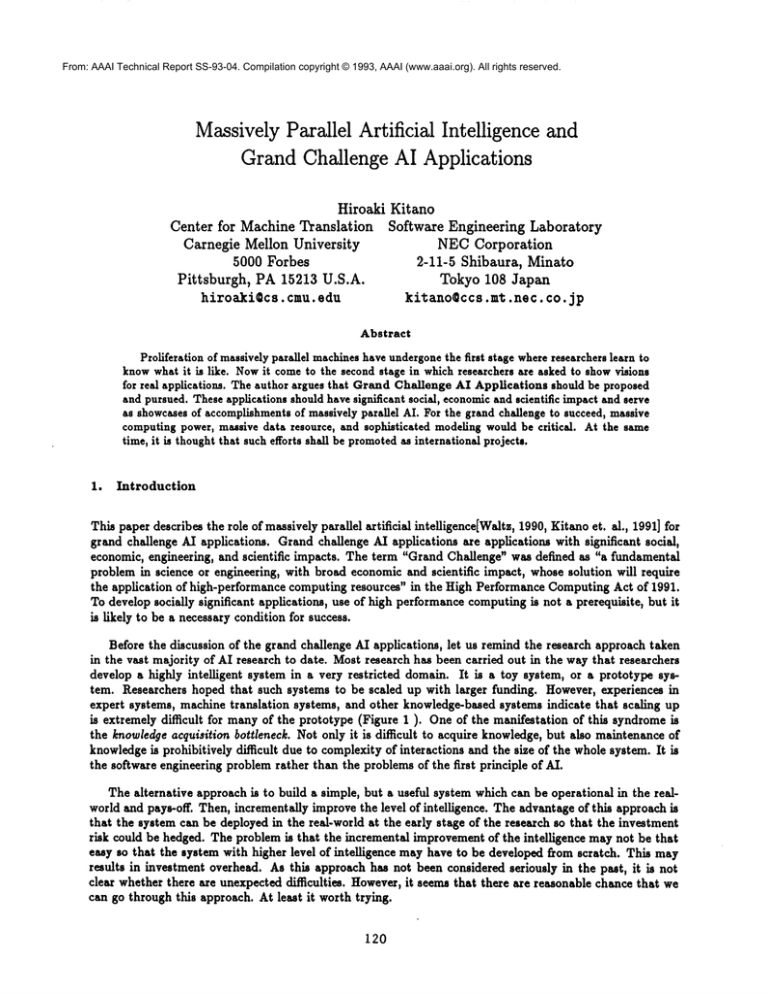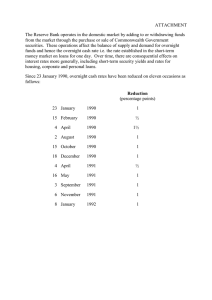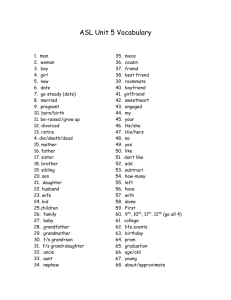
From: AAAI Technical Report SS-93-04. Compilation copyright © 1993, AAAI (www.aaai.org). All rights reserved.
MassivelyParallel Artificial Intelligence and
GrandChallenge AI Applications
Hiroaki Kitano
Center for Machine Translation Software Engineering Laboratory
NECCorporation
Carnegie Mellon University
5000 Forbes
2-11-5 Shibaura, Minato
Tokyo 108 Japan
Pittsburgh, PA 15213 U.S.A.
kitano@ccs
hiroaki@¢s,cmu. edu
.mr .nec.
co. jp
Abstract
Proliferation of massivelyparallel machineshave undergonethe first stage whereresearchers learn to
knowwhat it is like. Nowit cometo the second stage in which researchers axe asked to showvisions
for real applications. The author argues that Grand Challenge AI Applications should be proposed
and pursued. Theseapplications should have significant social, economicand scientific impact and serve
as showcasesof accomplishmentsof massively parallel AI. For the grand challenge to succeed, massive
computingpower, massive data resource, and sophisticated modeling would be critical. At the same
time, it is thought that such efforts shall be promotedas international projects.
I.
Introduction
This paper describes the role of massively parallel artificial intelligence[Waltz, 1990, Kitano et. al., 1991] for
grand challenge AI applications. Grand challenge AI applications are applications with significant social,
economic, engineering, and scientific impacts. The term "Grand Challenge" was defined as "a fundamental
problem in science or engineering, with broad economic and scientific impact, whose solution will require
the application of high-performance computing resources" in the High Performance Computing Act of 1991.
To develop socially significant applications, use of high performance computing is not a prerequisite, but it
is likely to be a necessary condition for success.
Before the discussion of the grand challenge AI applications, let us remind the research approach taken
in the vast majority of AI research to date. Most research has been carried out in the way that researchers
develop a highly intelligent system in a very restricted domain. It is a toy system, or a prototype system. Researchers hoped that such systems to be scaled up with larger funding. However, experiences in
expert systems, machine translation systems, and other knowledge-based systems indicate that scaling up
is extremely difficult for many of the prototype (Figure 1 ). One of the manifestation of this syndrome
the tmoroledge acquisition bottleneck. Not only it is difficult to acquire knowledge, but also maintenance of
knowledgeis prohibitively difficult due to complexity of interactions and the size of the whole system. It is
the software engineering problem rather than the problems of the first principle of AI.
The alternative approach is to build a simple, but a useful system which can be operational in the realworld and pays-off. Then, incrementally improve the level of intelligence. The advantage of this approach is
that the system can be deployed in the real-world at the early stage of the research so that the investment
risk could be hedged. The problem is that the incremental improvement of the intelligence may not be that
easy so that the system with higher level of intelligence may have to be developed from scratch. This may
results in investment overhead. As this approach has not been considered seriously in the past, it is not
clear whether there are unexpected difficulties.
However,it seems that there are reasonable chance that we
can go through this approach. At least it worth trying.
120
Taskcomplexity
Scalability
problem
Toy ~ Intelligent
system ~ system
|
~ns that
Syst~.
pay-]ff
Useful system
D
Domainsize
(Closenessto
the real-world)
Figure 1: Approachesfor Building Intelligent Systems
2.
Grand Challenge AI Applications
It is not an easy task to makea list of significant applications. However,there are certain applications which
could bring us obviousbenefits. Also, there are a group of applications whichcan be a symbolof engineering
and scientific accomplishments.
Twoworkshops were organized to discuss grand challenge AI applications. In Feburary 1992, NsF
sponsored "The Workshopon High Performance Computing and Communications for Grand Challenge
Applications: ComputerVision, Natural Languageand SpeechProcessing, and Artificial Intelligence."
In October 1992, the author have organized "The Workshopon Grand Challenge AI Applications" at
Tokyo,participated by a group of leading Japanese researchers[Kitano, 1992].
Whilethere are interesting differences in type of applications and key technologies proposedin between
Americanand Japanese workshops, the commonthread was the need for massive computingpower, massive
memorystorage, massive data resource, and ultra high band-widthcommunicationnetworks. Here is a part
of the list:
* Speech-to-speechtranslation system
¯ Humangenomeanalysis
¯ Global Architecture for Information Access(GALA),a highly intelligent information access system
e Shogi and Go system which beats ’Meijin’ (Grand Master)
¯ Intelligent robots and programswhichundertake daily tasks
¯ Intelligent Vehicles
Someof these are obvious and some projects are already running (Humangenome[NRC,
1988], speechto-speech translation, and somerobot works).
GAlAneeds some explanations. The idea of GAlAwas proposed by the author in 1992. It is an extended and moreintelligent version of the electric library. GAIA
access all possible informationsources, such
121
Accuracy
Accuracy
Score
f
y
¢
Search
Depth
(Ply)
P
Size of Memory-Base
D
Sophistication
of Model
Figure2: Improvement
of the qualityof Solution
vs. Increase
in Computing
Power,Data,and Modeling
Quality
as electric
dictionary[EDR,
1988],image,newspaper,
full-text
data,databases,
knowledge-bases[Lenat
and
Guha,1989],audio-visual
data,TV,andprovides
userswithflexible
andintelligent
accessto information.
Flexible
andintelligence
access
meansthatGAIAperforms
simple
retrieval,
similarity-based
retrieval,
scanning,summary,
translation,
trendanalysis,
andotherfunctions
whicharenecessary
to accessinformation.
Thus,GAIAcanalsobe readas General
Architecture
forIntelligent
Access.
Theauthorbelieves
thatsuch
system
canbe a basicinfrastructure
forvarious
rangeof intelligent
systems.
3.
Computing,
Memory,
and Modeling
Grand challenge AI applications are hard tasks. The author argues, however, that there are ways to accomplish these challenges. In this section, we examine one possible approach. The approach emphasizes massive
computing, massive data, and proper modeling. These are three major factors which leads us to successful
intelligent systems developments.
The importance of computing power can be represented by Deep-Thought Chess machine[Hsu et. al.,
1990, Hsu, 1990]. Deep-Thought demonstrates the power of computing using Chess. It was once believed
that strong heuristic approach is the way to build the grand master level chess machine. However, the
history of chess machine indicates that the computing power and the strength of the chess machine has
almost direct co-relation (Figure 2-LeR). Deep-Thought-r[ consists of 1,000 processors computing over
billion movesper seconds. It is expected to beat the grand master. Deep-Thoughtexemplify the significance
of the massive computing.
Memoryaspects can be argued from a series of success in memory-based reasoning. Starting from the
initial success of MBRtalk[Stanfill and Waltz, 1986], the memory-basedreasoning has been applied to various
domains such as protein structure prediction [Zhang at. al., 1992], machine translation [Sato and Nagao,
1990, Sumita and Iida, 1991, Furuse and Iida, 1992, Kitano and Higuchi, 1991a, Kitano, 1991], census
classification[Creecy et. al., 1992], parsing[Kitano and Higuchi, 1991b, Kitano at. al., 1991b], weather forecast, etc. PACE,a census classification system, attained the classification accuracy of 57%for occupation
code and 83% for industry code. AICOSexpert system attained only 37% for occupation code and 57%
for industry code. Example-Based Machine Translation (EBMT)developed by ATRInterpreting Telephony
Laboratory translates "A no B" phrase in Japanese, which is considered to be very difficult, at the accuracy
of 89%, whereas traditional
machine translation systems only attained about 40-50% of accuracy. ATR
also developed Transfer Driven MT(TDMT)which translates mixed-initiative
dialogue in 88.9% of accuracy. These success can be attributed to the superiority of the approach which place memoryas a basis of
intelligence, rather than fragile hand-crafted rules. In the memory-basedreasoning system, the quality of
solution depends upon the amount of data collected. Figure 2-Center shows the general relationship between
122
amount of data and quality of solution.
of the massive memory,or data-stream.
Success of memory-based reasoning demonstrates the significance
The importance of modeling can be discussed using SPHINXspeech recognition system[Lee, 1988]. Use
of massive computing and massive data-stream is not enough to build intelligent systems. The critical issue
is how we model the domain of application. Figure 2-Right shows the improvement of recognition rate with
sophistication of the modeling. Even if we use massively parallel machines and large data resources, if the
modeling was not appropriate, only a poor result can be expected. SPHINXexemplifies the significance of
the modeling.
4.
Massively
Parallel
AI as a basis
for Grand Challenge
AI Applications
The approach described will play an important role in grand challenge AI applications. Take an example of
spoken language translation system, it would have to be able to recognize speaker-independent, continuous
speech in real time. Recently, some researchers extended it into a vocabulary-independent system. Speech
recognition for this level of sophistication requires balk data processing and highly parallel processing to
attain high recognition rate in real-time. Translation module will be developed using extended versions
of memory-based reasoning. Success of EBMT,TDMT,and MBT-I demonstrate that the memory-based
approach is the promising option to pursue. In fact, we have implemented EBMTon CM-2and IXM2as a
part of the ATR-CMU
joint research. This provides us with high quality and real-time translation.
One other example is the grand master Shogi and Go machine. Shogi and Go has significantly
larger
search space than Chess. Search space of Chess is about 1012°, but Shogi and Go has search space of order
of 102°° and 10s°°, respectively. Shogi is a game similar to Chess, but the men taken by the opponent can
be redeployed as a men for the opponent. Thus, effective search space do not decrease even at near the end
of the game. Go has completely different game style and vast search space.
The traditional question would be raised again whether computing alone could solve this problem. The
author believes that use of massive computing and massive memorywith a proper modeling and machine
learning techniques will accomplish the grand master Shogi and Go machine. There are supporting evidences
to back up this claim. Humangrand master of Shogi and Go actually memorize scripts of all major matches
in the past, and use these memoryin the game. There is very high possibility that these grand masters are in
fact performing memory-basedreasoning. Humangrand master, obviously, use other forms ofinferencing and
search, too. However, combination of memory-based approach and efficient search and learning technique
will essentially simulates humangrand master. Throughthis research, we can expect discovery of new search,
memoryaccess, and learning techniques as it was a case in Chess machine. It is also scientifically significant
to test what level of Shogi and Go machine can we build just by using memory-based reasoning from all
av~lable scripts in the past. Such projects will inevitably shed light to nature of expert reasoning.
GAlArequires collective efforts to develop. While the preliminary system with no, or minimum,intelligence can be developed based on existing technologies such as massively parallel full-text retrieval [Stanfill
st. al., 1989, Elexir, 1991], message understanding and information extraction as seen in TIPSTERand
Message Understanding Conference (MUC),intelligent
systems require break thronghs in various aspects.
Search on very large knowledgebases requires a set of massively parallel search technique [Evett st. al., 1990,
Evett et. al., 1990, Geller, 1991]. Not only that intelligent processing scheme need to be developed, but
also efficient ways to create and store very large knowledge, text, AV-base need to be developed. Someof
these issues will be investigated in NOAHproject [NOAH,1992] and Real-World Computing Program by
MITI. There are some research on image retrieval, text-retrieval,
and message summaryusing memory-based
approach. Again memory-based approach and combination with other approacl~ are expected to accomplish
the challenge. Trend analysis and database mining requires massive computing power as complex operatious to induce rules from database has to be performed on large data sets. Massive parallelism is the key
technology for grand challenge.
123
5.
High Performance
Computing
Support
The approach described so far requires massive computing power and memory.There is constant progress in
hardware and device community to meet the demands[Gelsinger et. al., 1989, IEDM,1991]. Emergence of
1,000 MIPSprocessor and spreading of RISC architecture are obvious examples. Memoryis getting cheaper
and larger as Gigs-bits memorychips are in the mid-range target. High band-width interconnects, such as
200MB/Sec, are commonin recent days. There are projects for Gigs bits per second speed networks. In
addition, there are major efforts going on in the area of mass secondary storage.
Special purpose hardwares will be regarded as practical option for very high performance computing.
WSI-MBR,a wafer-scale integration for memory-based reasoning[Kitano and Yasunaga, 1992], can attain
over 70 teraflops when produced on 8-inch wafer using 0.3 micro design rule. It is technologically feasible
in 5 years. WSI-MBttis a hybrid analog/digital system optimized for MBR.It can store up to 2 million
records on one wafer. Using the wafer stack technology, may be with the micro-pin technology, pets-flops
and few hundreds million records systems are technically feasible.
CMOS
associative memorymay find its market nitch in the light of massively parallel AI and genetic
algorithms[Higuchi st. al., 1991, Kitano et. al., 1991a, Stormonet. al., 1992]. Associative memoryis a well
established technology which can be commercially manufactured in the short run.
Neural network devices are one other option. Again, use of WSIfor neural network device was alrady
proven to be effective[Yasunnga et. al., 1991].
Interconnection speeds up constantly as GIGAswitchand other technologies
optical connections with TeraHeltz calibration may come into play.
mature. In the long run,
Therefore, although substantial efforts has to be invested, the author is optimistic about the hardware
support. One thing to add, however, that the computing power should be regarded as national and international resource. Index such as Gross National Computing Power (GNCP)would be able to measure the
industrial strength.
6.
International
Cooperation
For the grand challenge to succeed, some form of international cooperation need to be carried out. Already,
HumanGenomeproject is an international projects. ATR’sinterpreting telephony project involves U.S. and
European groups to build a Japanese-English-German speech-to-speech translation system. The scale of
grand challenge applications inevitably draw in international aspects as no single institution or country can
afford development of truly significant systems with real-world scale. It is already happening now, and this
will be enhanced, and it need to be enhanced. The author has been organizing the International Consortium
for Massively Parallel Advanced ComputingTechnologies (IMPACT)to facilitate
international exchange
information and coordination of joint research efforts.
~’. Conclusion
This paper examined the relation between massively parallel AI and grand challenge AI applications. Although this paper merely focused on one of manyaspects of grand challenge and massively parallel AI, ample
evidences consistently indicate needs for massively paralle AI for grand challenge. The evidences also suggest that massive computing, massive data, and appropriate modeling are key for the success. International
cooperation would be inevitable in manyof grand challenge projects.
124
References
[Creecyet. al.,1992]Creecy,R., Masand,
B., Smith,S., and Waltz,D., "Trading
MIPSand Memoryfor Knowledge
n CommunicaEngineering:
Automatic
Classification
of CensusReturnson a Massively
ParallelSupercomputer,
tiona of the ACM,1992.
[EDR, 1988] Japan Electric Dictionary Research Institute,
Electric Diction~y Research Institute, 1988.
[NOAH,1992] Systema Research & Development Institute
1992.
"EDR Electric
Dictionaries,"
Technical Report, Japan
of Japan, A Plan for the Knowledge Archivea Project,
[Evett et. ed., 1990] Evett, M., Hendler, J., and Spector, L., PARKA:Parallel knowledge representation on the Connection Machine, Tech Report CS-TR-2409, University of Maryland, 1990.
[Evett et. al., 1990] Evett, M., Hendler, J., Mahanti, A., and Nau, D., "PRA*A memory-limited heuristic
procedure for the connection machine," Proceedings - Frontiers of Massively Parallel Computing, 1990.
search
[Furuse and Iida, 1992] Furuse, O. and Iida, H., "Cooperation between Transfer and Analysis in Example-Based
Framework," Proc. of COLING-9~, Nantes, 1992.
[Geller, 1991] Geller, J., Advanced Update Opcrationa in Massively Parallel Knowledge Representation,
Institute of Technology, CIS-91-28, 1991.
NewJersey
[Gelsinger et. al., 1989] GelRinger, P., Gargini, P., Parker, G., and Yu, A., "Microprocessors circa 2000," IEEE
Spectrum, Oct. 1989.
[Higuchi et. el., 1991] Higuchi, T., Kitano, H., Furuya, T., Kusumoto, H., Handa, K., and Kokubu, A., "IXM2:
A Parallel Associate Processor for Knowledge Processing," Proceedinga of the National Conference on Artificial
Intelligence, 1991.
[Hsu et. al., 1990] Hsu, F. H., Anantharaman, T., Campbell, M. and Nowatsyk, A., "A Grandmaster Chess Machine," Scientific Ame~can,Vol. 263, No. 4, Oct., 1990.
[Hsu, 1990] Hsu, F. H., Large Scale Parallelization of Alpha-Beta Search: An Algorithmic and Architectural
~oith Computer Chess, CMU-CS-90-108,Ph.D. Thesis, 1990.
[IEDM, 1991] IEEE, Proc. of the International
Sturdy
Electron Device Meeting (IEDM-91), 1991.
[Kitano and Yasunaga, 1992] Kits,o, H. and Yasunaga, M., "Wafer Scale Integration for Massively Parallel
Based Reasoning," Proceedings of the National Conference on Artificial Intelligence (AAAI-9~), 1992.
Memory-
[Kitano et. al., 1991a] Kitano, H., Smith, S. F., and Higuchi, T., "GA-I: A Parallel Associative MemoryProcessor
for Rule Learning with Genetic Algorithms," Proceedings of the International Conference on Genetic Algorithms
(ICGA-gl),
1991.
[Kitano et. al., 1991b] Kitano, H., Moldovan, D., Cha, S., "High Performance Natural Language Processing on
Semantic Network Array Processor," Proceeding of the International Joint Conference on Artificial
Intelligence
(IJCAI-91), 1991.
[Kitano et. al., 1991] Kitano, H., Hendler, J., Higuchl, T., Moldovaa, D. and Waits, D., "Massively Parallel Artificial
Intelligence," Proceeding of the International Joint Conference on Artificial Intelligence (IJCAI-91), 1991.
[Kitano and Higuchi, 1991a] Kitano, H. and Higuchi, T., "High Performance Memory-Based Translation on IXM2
Massively Parallel Associative MemoryProcessor," Proceeding of the National Conference on Artificial Intelligence
(AAAI-91), 1991.
[Kitano and Higuchi, 1991b] Kits,o, H. and Higuchi, T., "Massively Parallel Memory-BasedParsing,"
the International Joint Conference on Artificial Intelligence (IJCAI-91), 1991.
[Kitano, 1991] Kitano, H., "~DmDialog: An Experimental
Computer, June, 1991.
Speech-to-Speech
Dialogue Translation
[Kitano, 1992] Kitano, H. (Ed.), Proceedings of the Worl~ahopon Grand Challenge AI Applications,
Japanese)
125
Proceeding of
System," IEEE
Tokyo, 1992. (in
[Lee, 1988] Lee, K. P., Large-Vocabulary Speaker-Independent Continuous Speech Recognition:
CMU-CS-88-148, Ph.D. Thesis, 1988.
The SPHINXSystem,
[Lenat and Guha, 1989] Lenat, D. B. and Guha, R. V., Building Large Knowledge.Based Systemss Addlson-Wesley,
1989.
[NRC, 1988] National Research Council,
Washin8ton, D.C., 1988.
Mapping and Sequencing the Human Genome, National
[Sato and Nagao, 1990] Sato, S. and Nagao, M., "Toward Memory-based Translation,"
1990.
Academy Press,
Proceedings of COLING.gO,
[StanfiU
et.al.,1989]Stanfill,
C.,Thau,R.,andWaltz,
D.,"A Parallel
Indexed
Algorithm
forInformation
Retrieval,"
Proceedings o~ the $IG-IR-89, 1989.
[Stanfill
and Waltz, 1986] StanfiU, C. and Waltz, D., "Toward Memory-Based Reasoning," Communications of the
A CM, 1986.
[Stormon et. al., 1992] Stormon, C., Troulllnos, N., Saleh, E., Chavan, A., Brule, M., and Oldfield, J., "A GeneralPurpose CMOSAssociative Processor IC and System," IEEE Micro, December, 1992.
[Sumita and Hda, 1991] Sumlta, E., and Hda, H., "Experiments and Prospects
tion," Proceedings of the Annual Meeting of the A CL (A CL-91), 1991.
of Example-Based Machine Transla-
[Elexir, 1991] Thlrd Eye Softwaxe, Elezir, 1991.
[Waltz, 1990] Waltz, D., "Massively Parallel
(AAAI.gO), 1990.
AI," Proceedings of the National Conference on Artificial
Intelligence
[Yasunaga et. al., 1991] Yasunaga, et. al., "A Self-Learning Neural Network Composed of 1152 Digital Neurons in
Wafer-Scale LSIs," Proc. o/the International Joint Conference on Neural Networks at Singapore (IJCNN.91),
1991.
[Zhang et. al., 1992] Zhang, X., Mesirov, J., and Waltz, D., "Hybrid System for Protein Secondary Structure
diction," J. Mol. Biol., 225, 1049-1083, 1992.
126
Pre-





